Aside from some short stints of formal study, Richard Pepitone was a self-made artist. A sculptor by profession, he was energetic, prolific, and fearless in his work.
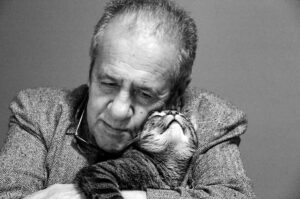
Pepitone, who died at 86 on Nov. 8, 2022, is the subject of a retrospective exhibition at the Provincetown Commons this month. His daughter, Michelle Pepitone, curated the show, which includes 50 pieces spanning the artist’s early days in Provincetown to his last months working in a studio at the Commons. The exhibition reveals Pepitone’s curiosity, encompassing a wide range of mediums: polyester resin, bronze, ceramics, stained glass, monoprints, pencil, and paint.
“I always loved his work,” says Michelle, who traveled from her home in Pittsburgh for the installation and opening reception. “I saw it all the time. It became a part of my life.”
Pepitone’s artwork was also well loved by others around town, including his fellow artists at the Beachcombers Club at the Hulk, a gray-shingled former wharf house in Provincetown’s East End.
“So who are the Beachcombers? Think: Century Association and Skull & Bones — in a camel costume,” writes David Dunlap in The Provincetown Encyclopedia. Founded in 1916, the men’s club is “an arts organization that takes its mission and itself quite seriously, but that can’t help indulge sometimes in hijinks that would have been more or less appropriate for a boys’ summer camp,” Dunlap continues.
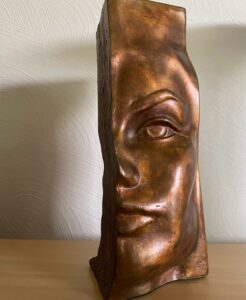
A concurrent exhibition at the Commons, curated by Robert Longley and Stephen Wells, will feature artwork by other members of the Beachcombers, including some portraits of Pepitone. “He seemed to be a little bit of a muse, albeit an oddball one,” says Michelle.
Born in Bedford Stuyvesant, Brooklyn in 1936, Pepitone had a tough start. He ditched school in fifth grade and spent eight years of his youth in and out of institutions. He was incarcerated thanks to his penchant for thievery, temper issues, and his “extended truancy,” he wrote in his memoir Gone for the Day, published by Provincetown Public Press in 2015.
As a teenager, Pepitone met the future heavyweight boxing champion Floyd Patterson at Rockland State Hospital in New York. Pepitone had been sent there after having run away to Los Angeles; Patterson was 15. The two bonded, and their friendship marked a turning point for Pepitone, with Patterson serving as a model of someone who had achieved self-control.
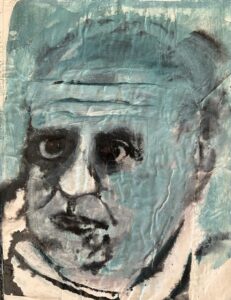
Pepitone first developed a propensity for art at age 10 in an arts and crafts class at King’s County Hospital, where he was introduced to plaster and molds. By the time he was 20 he had moved to Greenwich Village determined to become an artist. There, he apprenticed with the German-born modernist sculptor Alfred Van Loen, whose works merged figurative and organic forms. The gentle curves of Van Loen’s artwork would have a lasting influence on Pepitone’s.
A few years after his apprenticeship, Pepitone left New York City to study in Italy and met Alberto Giacometti, one of the 20th century’s most influential sculptors, in Paris. After returning to New York, he opened a studio in the East Village in 1960, where he met his wife, Kay. The two moved to Provincetown in 1969 to lead a quieter and more focused life, Michelle says.
Pepitone made polyester resin sculptures in those early Provincetown years. He often smashed molds of the human form to create sculptures that appear fragmented, figurative, and abstract. This aesthetic is evident in one bronze sculpture on display at the Commons. A woman’s head is halved. Her thick eyebrow and vacant eye stare out at the viewer with the disaffected poise of a beautiful yet fractured person.

When the couple divorced, Michelle went with her mother to California because her father was “married to his work.” But Pepitone followed them for a spell to help raise her, Michelle says. He returned to Provincetown, and Michelle visited during the summers.
Here, Pepitone developed new approaches to his work, gaining a self-possessed mastery in anything he turned his attention to. The human figure remained a consistent interest throughout his life.
In one figure drawing from 2006, he lets his ink roll, never lifting his drawing implement from the page. The 13 or so figures look like they’re on a crowded dance floor; the consistent line articulates movement and free-flowing uniformity.
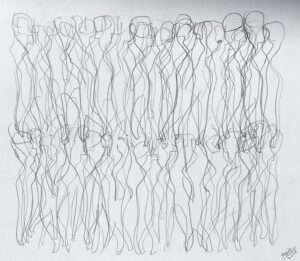
In a self-portrait in black, white, and robin’s-egg blue, Pepitone shows a sense of humor. His big curious eyes are nearly crossed into his prominent nose. The viewer cannot figure out where he’s looking, although it seems one eye might be looking out at the viewer.
In another piece, a ceramic container, nude figures dance with their arms raised as if they’re in worship. Some rebirth is happening, something new against the smokey black background.
Pepitone painted with just about everything, according to Robert Longley, who joined the Beachcombers in 1989. “He’d squeeze ink out of a walnut,” says Longley. He remembers Pepitone’s curiosity about color, which Longley had studied with Henry Hensche, a Provincetown colorist and influential teacher.
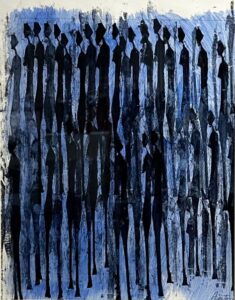
Later in life, Pepitone would present variations on his earlier work. “It was a twist that made it new but familiar,” says artist Bill Evaul, a fellow Beachcomber. The exhibition at the Commons, “Variations on a Theme,” will show how he often borrowed imagery from his past work to create something new.
It’s fitting that Pepitone’s work will be exhibited alongside his peers from the Beachcombers Club, as the group provided him friendship and dialogue that spurred on his development as an artist. The club has helped keep Pepitone’s creative legacy in view. “The club anchored my father in a way that only the closest family can,” says Michelle. “It is hard to imagine my father’s life in Provincetown without the Beachcombers.”
Fearless Friends
The event: ‘Variations on a Theme,’ works by Richard Pepitone and the Beachcombers
The time: Through Nov. 24; reception Friday, Nov. 15, 5 to 8 p.m.
The place: Provincetown Commons, 42 Bradford St.
The cost: Free

